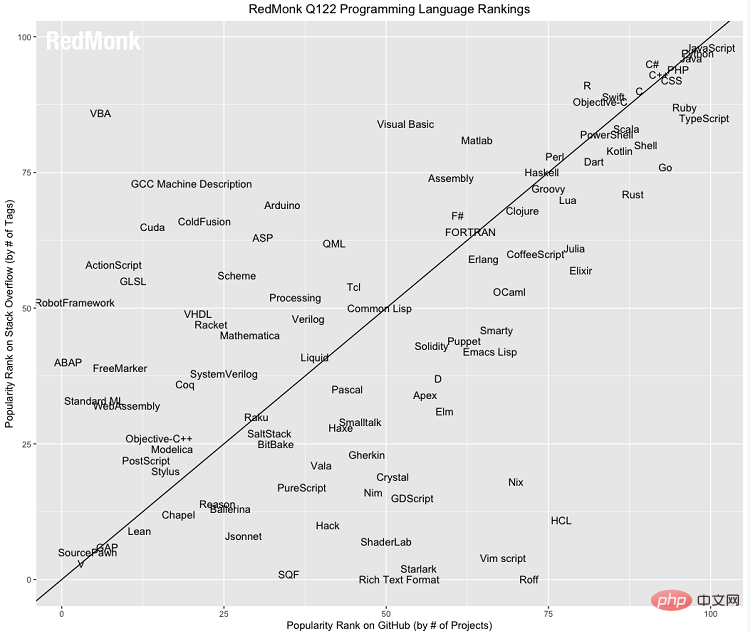RedMonk, a well-known software industry analysis company, released the programming language rankings for January 2022 (first quarter).
RedMonk Programming Language Rankings aim to gain insights into potential language adoption trends by tracking the code usage and number of discussions of programming languages on GitHub and Stack Overflow, and ranking them after statistical analysis. The list is published twice a year and this is the first list of this year.
Currently, the basic idea of RedMonk’s sorting algorithm for programming languages has not changed, but the specific data collection method has changed. GitHub Archive is now used as the data source to analyze GitHub data; for the Stack Overflow part, the utility tool data explorer provided by Stack Overflow is directly used. For the specific sorting algorithm, see the official introduction: https://redmonk.com/sogrady/2022/03/28 /language-rankings-1-22/
The following picture shows the programming language rankings of Q1:

##Ranking The top 20 programming languages are:
1 JavaScript2 Python3 Java4 PHP5 CSS 5 C#7 C 8 TypeScript9 Ruby10 C11 Swift12 R13 Objective-C14 Shell14 Scala16 Go17 PowerShell18 Kotlin19 Rust19 DartAs usual, the rankings this quarter have not changed much and are stable. For its part, RedMonk points out that, with a few notable exceptions to be discussed, the pattern of language movement in recent years has been that there has been little movement at all. In fact, 17 of the 20 languages here have remained stable for three consecutive quarters. This raises an interesting question: is this stability representative of industry usage, or is it more akin to a process artifact? As movement in these rankings begins to diminish, it's interesting to consider whether we might be entering an era of relative stagnation. Of course, new languages will continue to emerge, and some may rise due to the addition of new features or external factors (such as Dart below); but when we look around the industry, there may be some balance forming. Languages find their niche and reach parity with specific competitors. It’s too early to tell, and all of this may be neither human factors nor industry shifts, but the result of other external factors. The ongoing pandemic and its widespread effects, visible and invisible, are Obvious candidate. Regardless, it's something we'll be watching closely.
RedMonk analyzed and commented on the ranking changes of individual programming languages in this ranking:
Python (0) / Java (-1) :
After briefly tying for second place with Python, Java slipped back to third place. To be clear, though, finishing third on this list is still a very impressive achievement. But observers point out that Python’s sustainable strength is worth watching, as it has ranked second on this list for two consecutive years and is once again on par with the most popular enterprise development languages and The language of one of the world's two largest mobile ecosystems has distanced itself. This is quite an achievement for a language that some deride as "just a glue language".PHP (0):
PHP is unchanged on this list. But that’s not surprising, as PHP has been in fourth place since 2017. Observers note that it's important to note that after all these years, PHP is still looked down upon. But regardless of what people think of it, PHP still has its power.C (-2):
In the previous list, C ranked fifth, tied with C# and CSS. But this time, it was one of the few languages to see a change; it dropped two spots to seventh. "While this decline may be purely temporary, one wonders whether it will follow in the former's footsteps." Early on the list, C ranked eighth, then slipped to ninth, and now it is It's the tenth. Meanwhile, the last time C ranked as low as 7 was in 2013 for its second time on the list. "It will be interesting to see if this is just a blip, or if this decline represents a new baseline for the language moving forward, and if there is further decline to come."TypeScript (0):
Speaking of falling further, just behind C in the rankings is TypeScript. TypeScript is the fastest growing language since Swift and the only one of the two to make the top 10 list. Observers note that TypeScript appears to be entering a plateau, having held the position exclusively for the past three quarters. The question is whether the language has more room to grow, or whether this is the upper limit of the language. "It is not easy to climb up. Even if C has fallen this time, it already has a lot of code and related discussions; if TypeScript wants to continue its upward journey, languages like C Just what it needs to be more than”.Dart (1) / Rust (0) / Kotlin (0):
Somewhat surprisingly, as the two most "hot" languages recently, Kotlin (#18) and Rust (#19) have not changed. But even more surprising is that Dart was able to move up one spot and tie with Rust in 19th place.
It took Kotlin two quarters to make this jump, and Rust took one quarter. However, after hovering around the 30th position on the list for about 36 months, Dart not only entered the top 20, but also kept pace with the developer's "darling" Rust. "The two most important questions now are, first, whether it can maintain this position, and if so, whether there is more room for growth."
Let's take a look at what major netizens think about it Ranking comments and opinions:

What do you think? Welcome to leave a message to participate in the discussion